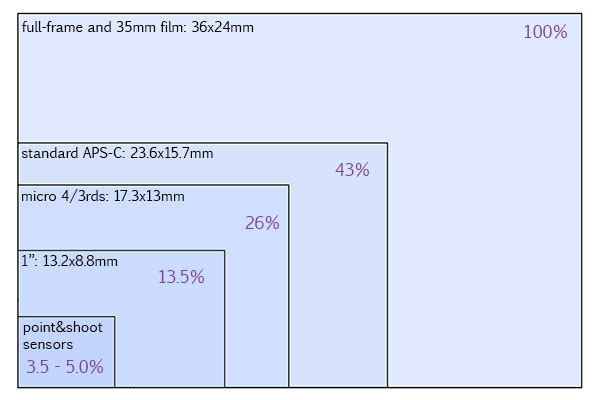Cotton's Guide to Camera Shopping, 2016
Page 3 of 6. Version 1.0, ©2016 by Dale Cotton, all rights reserved.
Full Frame vs. APS-C vs. Micro 4/3rds
A full frame camera has a sensor that's the same size as 35mm film: 24x36 mm or 864 mm2 with a 2:3 aspect ratio. APS-C sensors are the same size as APS-C film: 23.6 x 15.7 mm or 370 mm2 with a 2:3 aspect ratio. (Canon's APS-C is smaller at 22.2 x 14.8 mm.) Micro 4/3rds sensors are 17.3 x 13 mm or 225 mm2 with a 4:3 aspect ratio.
Simplistically, the larger the sensor the more light goes into creating a given image. This should result in a better signal-to-noise ratio, for a cleaner, purer image. In practice many other variables are involved, with the biggest being the efficiency of the sensor's light capturing technology. (The latest generation of Sony's Exmor sensors are significantly ahead of the competition, although Samsung's most recent proprietary sensors are in the ballpark. Nikon, Olympus, Fuji, and Pentax tend to use Sony sensors.)
Another result of these differences in sensor size is that the same actual focal length on a full frame camera covers a greater portion of the scene than either APS-C or M43. This is called a crop factor. Multiply the focal length of lenses on an APS-C camera by 1.6 for Canon or 1.5 for any other manufacturer to get the equivalent coverage for a full frame lens. For example, a 50 mm lens on a Nikon APS-C camera provides the same view of the scene as a 75 mm lens on a FF camera. For M43 you simply double the focal length. So a 50 mm lens on an Olympus or Panasonic camera provides the same view coverage as 100 mm lens on FF camera. (Except it doesn't quite, because of the difference in aspect ratio.)

Shallow DOF (Sony A7+28-70 at f/4.5)
Yet another difference between these formats is called depth-of-field (and should be called depth-of-focus) or DOF. Skipping technicalities, if you have the same view of the scene and same aperture using a FF, an APS-C, and an M43 camera plus lens, you're getting 1.5 or 1.6 times more of the scene in focus from near to far with APS-C than FF, and 2 times more from M43. This is an advantage of the smaller formats if you're trying to get everything in focus. If you're trying to deliberately blur near or far portions of the scene, then it's a liability.
The smaller sensor size permits scaling the camera body and lenses down proportionately for a savings in weight and bulk. About the only correlation between sensor size and camera price is that full frame sensors remain expensive to manufacture, so full frame cameras tend to start in price where APS-C and M43 leave off.
The APS-C sensor dSLR was the meat-and-potatoes of the interchangeable lens camera market from the start of the digital era until recently. But as smart phone cameras started to make drastic in-roads on stand-alone camera sales, manufacturers have increasngly turned to full frame. The business model that manufacturers are using now is to sell few cameras at higher price targeting the photography enthusiast. Full frame, whether SLR or mirrorless, is the current high-appeal tech.
The FF appeal rests on a low-noise image, high resolution quality, the ability to work at very high ISOs without flash, the ability to re-use film-era lenses, and most of all the ability to achieve very shallow DOF, separating subject from background. APS-C and M43 get the job done with less weight and lower cost in the vast majority of cases, but to the die-hard photo enthusiast FF carries the day.
